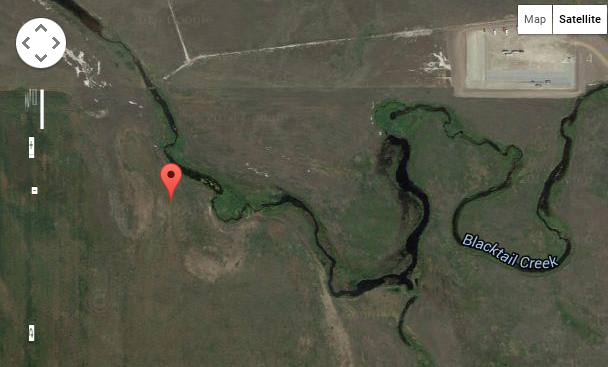The news is out; the brine spill on Blacktail Creek will go down as one of the state’s worst oil-related spills. We’re now a full two weeks removed from the event, and it’s just now that some of the actual details are coming to light.
This Was a Big Spill
Sensationalism aside, the reality of this release is that it was big, by any measure.
By the Numbers:
- Brine Spilled: 2,940,000 Gallons — 70,000 Barrels — 4.45 Olympic Pools.
- Oil Spilled: Unknown. The oil was mixed with the brine in the pipeline making estimates understandably difficult. I think it’s safe to assume this was a small portion of the total spill.
By Comparison:
The amount of contaminant released was roughly one-quarter the amount released in the Exon Valdez spill.
- Exon Valdez (oil): 11,000,000 Gallons — ~260,000 Barrels — 16.66 Olympic Pools. (source)
The Location
The spill occurred near Blacktail Creek, a small creek that flows into the Little Muddy River, which then joins the Missouri River on the East side of Williston. Every spill is bad, but this one was in a particularly bad spot because the released saltwater quickly entered the watershed, effectively spreading the contamination over many miles downstream.
Tip: Close the info boxes on the map by clicking in the top right corner. The close ‘X’ is only lightly visible.
[map_locations]
Remediation & Clean Up
Summit Midstream (the company responsible, also known as Meadowlark) has hired an environmental contractor to help with clean up, and trucks were on site pumping water from Blacktail Creek at least as early as January 9th. To date, over 64,000 barrels of water (2.7 million gallons) have been pumped from Blacktail Creek, but much of that has been diluted freshwater newly entering the watershed.
The cleanup put in perspective: Remediation on a 2006 spill at Charbonneau Creek of 46,000 barrels continues to this day, nearly a decade later.
The Effect on Wildlife
We have no idea. The challenges of a North Dakota winter and ice cover make learning the full environmental impact difficult if not impossible to determine.
How Do We Prevent This From Happening Again?
Spills happen; it’s a part of the oil recovery process and most of us who have a balanced attitude towards the industry understand that point. However, that doesn’t mean we can offer anyone a pass on incidents like this, be they from the State or the private sector. In his article yesterday, Zack Nelson of the Williston Herald started pushing towards some of the questions we all need to be asking. I’ll bring out some of his thoughts and add a few of my own below.
On Reporting, Responding, & Investigating
If you read the incident report from the Department of Health, you start to get a sense of the timeline regarding the incident and the response. There are questions we need to raise from the start.
From the incident report:
“The saltwater pipeline was shutdown on the evening of 01/06/2015 and Summit Midstream employees walked the right of way to try to find the source of the leak. Once the leak location was identified, environmental response teams, and Summit Midstream first responders were immediately notified and dispatched to the location.”
Continued from the report:
“Company rep contacted NDDoH at 1:04 PM 1/7/2014, notifying it of this spill.”
Nevermind the fact that it took Summit Midstream two weeks to report the actual spill amount, let’s look at the fact that it took more than 15 hours before anyone called the state to report the spill. For most spills that’s probably not that big deal, but, in this case, the spill was in the water and actively getting away. With regards to notifying the state, the situation should have had a more urgent quality.
For me, this raises a lot of questions…
First, I’m neither surprised nor overly offended by Summit Midstream’s actions. In my mind, this response is exactly what we should expect from private industry in a loosely regulated system — they will work to protect their interests first. Once that base is covered and if they’re a good operator, they’ll do everything they can to remain in compliance with the law.
The big question is this: is that good enough for North Dakota?
Another question I have — how in the world do we not know how long the pipe had been leaking prior to discovery of the release?
Think about it… four-inch pipe (or the size of the hole), 70,000 barrels. There aren’t that many variables in this equation and the one that matters most, the operating pressure (psi) of the gathering system, should not be an unknown. We don’t need two weeks to answer this question, we need two hours.
But again, I’m not surprised that Summit Midstream is, according to the Williston Herald, “still doing testing to determine a timeline.” The duration of the spill prior to discovery speaks volumes towards whether the full impact of this incident was the result of an accident (pipes break, we get it) or negligence (pipes break, we get it, but it took you three days to notice).
My question is this, should we be relying on Summit Midstream (or any responsible party) to provide us with the evidence that will determine if this is just an accident or a negligent act? Granted, that’s a simplification of the process, but I hope you catch my meaning — this incident exposes some problems with our system.
I have no great love of government regulation and bureaucracy, but there are certain situations where the incentives in the system are simply too significant to rely on good faith and handshakes. And in the case of oil spills, I don’t think we’re wrong or being overly burdensome if we require an immediate phone call and more transparency in the immediate aftermath of an incident — at least in cases where the spill is on the move or in the water.



